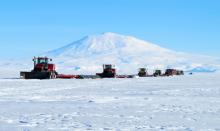What Are They Doing?
 Trawling catch in Antarctica
Trawling catch in Antarctica
Antarctic notothenioid fishes are uniquely adapted to life in the extreme conditions of the Southern Ocean. Waters surrounding Antarctica are unlike any other. The Southern Ocean is isolated from other oceans by the Antarctic Circumpolar Current, it is very cold with temperatures at or near -1.8 degrees Celsius, and the water is rich in oxygen. Notothenioids have evolved many physiological traits that enable them to survive in this remarkable environment. They lack a swim bladder and have antifreeze proteins that prevent their bodies from freezing. Members of one family of notothenioids, the Channichthyidae (icefishes), are unique among all vertebrates because they lack the circulating oxygen-binding protein, hemoglobin.
The loss of hemoglobin is considered a neutral mutation; one that neither enhances nor reduces fitness. However, the team hypothesizes that the loss of hemoglobin may be an advantage because hemoglobin promotes the formation of reactive oxygen species that damage macromolecules. Overall, the team's research was aimed at understanding the unique physiological and biochemical traits that have arisen in fishes during their evolution in the chronically cold waters of the Southern Ocean.
Where Are They?
 Palmer Station, Antarctica
Palmer Station, Antarctica
Members of the research team boarded the Research Vessel (R/V) Laurence M. Gould in Punta Arenas, Chile for a four-day voyage to Palmer Station, Antarctica across the Drake Passage, infamously known for its rough seas. The team first traveled to Punta Arenas by plane and had to arrive two days prior to the ship leaving the dock to receive their cold weather field clothing. Palmer Station is operated by the U.S. Antarctic Program and is among the smallest of three United States research stations located in Antarctica. During the austral summer up to 44 people live and work at the station, with that number going down to between 15 and 20 during the winter months.
Latest Journals

Kristin O'Brien is an associate professor of biology at the Institute of Arctic Biology within the University of Alaska Fairbanks. Her research is aimed at understanding how fishes maintain energy production at cold temperatures. She investigates the unique physiological and biochemical adaptations that have arisen in Antarctic fishes during their evolution in the icy cold waters of the Southern Ocean. Learn more about Dr. O'Brien and her work here.

Lisa Crockett is an associate professor of physiology in the Department of Biological Sciences at Ohio University. Lisa's primary interests are in metabolic cold adaptation and how membrane compositions are reorganized with variations in body temperatures. Lisa first began working in Antarctica as an undergraduate student with Dr. Art DeVries who discovered the antifreeze glycoproteins in Antarctic fishes. In addition to her role as collaborator in Antarctica, she also studies temperate fishes (e.g., striped bass, saltmarsh minnows and American eel) and the physiological and biochemical mechanisms that enable these animals to tolerate a wide range of temperatures and salinities. You can read more about her work here





